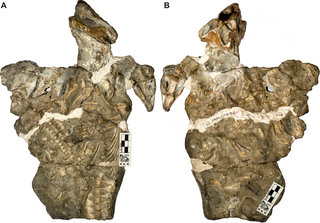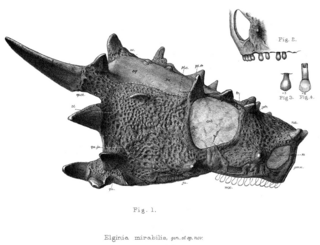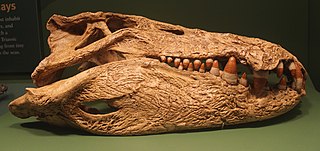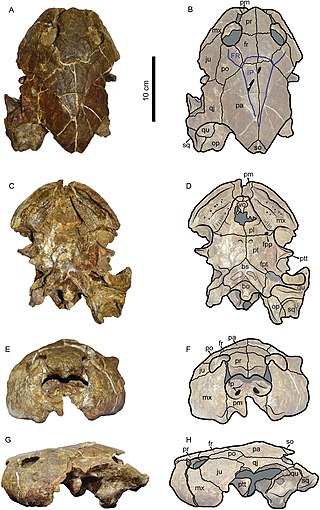
Galesaurus is an extinct genus of carnivorous cynodont therapsid that lived between the Induan and the Olenekian stages of the Early Triassic in what is now South Africa. It was incorrectly classified as a dinosaur by Sir Richard Owen in 1859.

Elginia is an extinct genus of pareiasaurid known from the Late Permian of Scotland and China. It was named for the area around Elgin in Scotland, which has yielded many fossils referred to as the Elgin Reptiles.

Globidens is an extinct genus of mosasaurid oceanic lizard classified as part of the Globidensini tribe in the Mosasaurinae subfamily.

Paludirex is an extinct genus of mekosuchine crocodylian from the Pliocene and Pleistocene of Australia. A large and robust semi-aquatic ambush hunter capable of attaining lengths of up to 5 m (16 ft), it was likely the top predator of Australia's waterways prior to the appearance of modern saltwater crocodiles. Two species are known, the smaller Paludirex gracilis and the larger Paludirex vincenti. A third as of yet unnamed species may have also existed.
Judeasaurus is an extinct genus of small, aquatic varanoid lizard related to the mosasauroids. The only known specimen is from the Late Cretaceous of the Judean Hills around Israel and the West Bank, though its exact provenance is uncertain.

Mahajangasuchus is an extinct genus of crocodyliform which had blunt, conical teeth. The type species, M. insignis, lived during the Late Cretaceous; its fossils have been found in the Maevarano Formation in northern Madagascar. It was a fairly large predator, measuring up to 4 metres (13 ft) long.

Harpacochampsa is a poorly known Early Miocene crocodilian from the Bullock Creek lagerstätte of the Northern Territory, Australia. The current specimen consists of a partial skull and fragments of a long, slender snout reminiscent of that of a false gharial, demonstrating that it was a piscivore in life.

Euthecodon is an extinct genus of long-snouted crocodile. It was common throughout much of Africa during the Neogene, with fossils being especially common in Kenya, Ethiopia, and Libya. Although superficially resembling that of gharials, the long snout was a trait developed independently from that of other crocodilians and suggests a diet of primarily fish. Euthecodon coexisted with a wide range of other crocodiles in the areas it inhabited before eventually going extinct during the Pleistocene.
Zapatadon is an extinct genus of sphenodontid reptile from the end of the Early Jurassic in the lower part of La Boca Formation of Tamaulipas, Mexico. Is known from a nearly complete skull with mandible of a post-hatchling individual, and is one of the smallest skulls between the sphenodontians, with an estimated total length of 11.3 millimetres, a bit smaller than the hatchling individuals observed in the modern tuatara (Sphenodon); features like the oblique mandibular symphysis suggests that the holotype is from an individual in a relatively mature stage of ontogenic development. Zapatadon is diagnosed by their hatchling tooth series located in a depression in the anterior part of the dentary bone, the prefrontal bone surrounding the dorsal process of the maxilla and the broad jugal that extends over the maxillary suborbital process, been almost excluded of the orbit.

Jesairosaurus is an extinct genus of early archosauromorph reptile known from the Illizi Province of Algeria. It is known from a single species, Jesairosaurus lehmani. Although a potential relative of the long-necked tanystropheids, this lightly-built reptile could instead be characterized by its relatively short neck as well as various skull features.

Crocodylus checchiai is an extinct species of crocodile from the Miocene to Pliocene of Libya and Kenya. C. checchiai was named in 1947 based on a skull from the Sahabi Formation. Remains from the lower Nawata Formation in the Turkana Basin of Kenya that were first attributed to the Nile crocodile have now been reassigned to C. checchiai, extending its geographic range. The morphology of the species, in particular the pronounced rostral boss, indicates that it may be the connecting link between African and American species of the genus Crocodylus.

Palatodonta is an extinct genus of neodiapsid reptile known from the early Middle Triassic of the Netherlands. It was initially described in 2013 as a basal placodontiform closely related to a group of marine reptiles called placodonts, characterized by their crushing teeth and shell-like body armor. Under this interpretation, Palatodonta is transitional between placodonts and less specialized reptiles. Like placodonts, it has a row of large teeth on its palate, but while these teeth are thick and blunt in placodonts, Palatodonta has palatal teeth that are thin and pointed. A 2023 study instead classified it as a sauropterygomorph and the sister taxon to Eusaurosphargis. In other words, it is close to, but not within, Sauropterygia.
Australochelys is an extinct genus of rhaptochelydian turtle. It is known from one species, A. africanus, that came from the Elliot Formation of South Africa. The holotype of Australochelys consists of only a skull and a fragment of the carapace, which shows both primitive and derived features. Like Proganochelys, Australochelys has large orbits and a ventral basioccipital tubercle, but like derived turtles such as casichelydians, a group containing Cryptodira and Pleurodira, it possesses a sutured basipterygoidal attachment, and a middle ear region partially enclosed laterally. These characteristics show that Australochelys is more closely related to casichelydians than to Proganochelys, and together with the former, it makes up Rhaptochelydia. The skull of Australochelys shows that an advanced hearing mechanism of turtles evolved before the appearance of modern turtles.

Anthracosuchus is an extinct genus of dyrosaurid crocodyliform from the Paleocene of Colombia. Remains of Anthracosuchus balrogus, the only known species, come from the Cerrejón Formation in the Cerrejón mine, and include four fossil specimens with partial skulls. Anthracosuchus differs from other dyrosaurids in having an extremely short (brevirostrine) snout, widely spaced eye sockets with bony protuberances around them, and osteoderms that are smooth and thick. It is one of the most basal dyrosaurids along with Chenanisuchus and Cerrejonisuchus.

Astorgosuchus is an extinct monospecific genus of crocodilian, closely related to true crocodiles, that lived in Pakistan during the late Oligocene period. This crocodile may have reached lengths of up to 8 m (26 ft) and is known to have preyed on many of the large mammals found in its environment. Bite marks of a large crocodile have been found on the bones of juvenile Paraceratherium, however if these were left by Astorgosuchus cannot be said with certainty. The genus contains a single species, Astorgosuchus bugtiensis, which was originally named as a species of Crocodylus in 1908 and was moved to its own genus in 2019.

Caninemys is an extinct genus of large freshwater side-necked turtle, belonging to the family Podocnemididae. Its fossils have been found in Brazil and Colombia, in rocks dating back from the middle to late Miocene.

Kalthifrons is an extinct monospecific genus of mekosuchine crocodylian known from the Pliocene Tirari Formation of Australia. More specifically, Kalthifrons was recovered from the Mampuwordu Sand Member, which underlies the younger sediments of the Pompapillina Member. This is significant, as the latter preserves some of the earliest records of the genus Crocodylus in Australia, which would eventually go on to replace mekosuchines. It is currently unclear whether or not the Tirari Crocodylus directly outcompeted Kalthifrons or simply moved into the region after the niche was left empty by the extinction of the local mekosuchines. Should the later be the case, then Kalthifrons may have simply been the victim of global cooling and aridification. A point in favour of the competition hypothesis is that both Kalthifrons and the Tirari Crocodylus have broadly similar skull forms, with both being interpreted as generalist semi-aquatic predators much like many of today's crocodiles. Though far from large, Kalthifrons was nonetheless bigger than many other mekosuchines such as Trilophosuchus and Mekosuchus. The genus is monotypic, meaning it contains only a single species, Kalthifrons aurivellensis.

Kyhytysuka is an extinct genus of ophthalmosaurian ichthyosaur from Early Cretaceous Colombia. The animal was previously assigned to the genus Platypterygius, but given its own genus in 2021. Kyhytysuka was a mid-sized ophthalmosaurian with heterodont dentition and several adaptations suggesting that it was a macropredatory vertebrate hunter living in shallow waters. It contains a single species, Kyhytysuka sachicarum.

Kosmodraco is a genus of large bodied choristodere from the Paleocene of North America. Originally described as a species of Simoedosaurus, it was found to represent a distinct genus in 2022. Multiple fossil skulls show a relatively short and robust snout and a skull that is considerably wider behind the eyes. Two species are currently recognized, K. dakotensis and K. magnicornis.
Sacacosuchus is an extinct monospecific genus of marine gavialid that lived along the coast of the south-east Pacific from approximately 19 to 6.3 million years ago. Its fossils have been found in the Chilcatay and Pisco Formations of Peru, where it coexisted with the much larger Piscogavialis. Based on its skull, Sacacosuchus was most likely a generalist feeder with an estimated total body length of 4.32 m (14.2 ft). Its extinction is thought to have been caused by a combination of factors including falling sea levels and global cooling.


















